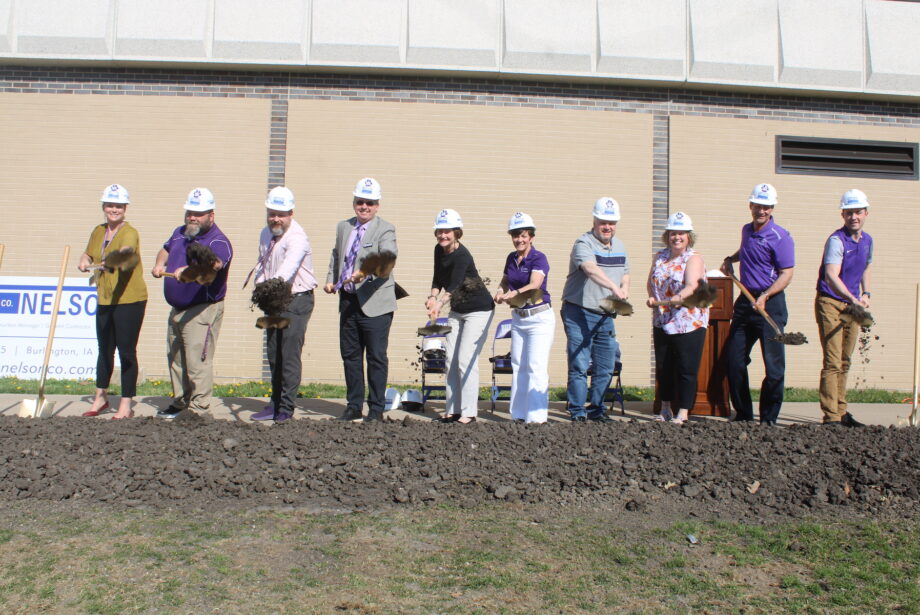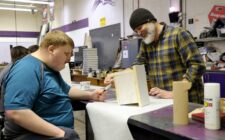Phase II of the $35 million renovation of and addition to Burlington High School has begun.
Within temporary fencing set up just north of the Burlington High School tennis courts, an excavator and work crew are digging into the ground to lay the foundation for what will be a fitness center and the first in a long list of improvements coming to the campus.
On a windy but sunny afternoon in April, Burlington Community School District and BHS administrators and teachers gathered here with school board members, city leaders and representatives of construction management agency Carl A. Nelson & Co. and Davenport-based Bray Architects to break ground on what will be the largest construction project to take place in Burlington since work on the Catfish Bend Casino began in 2006.
“Today, after years of planning, we are breaking ground on a $35 million renovation project that will bring this building forward to the state-of-the-art status and glory our students and staff deserve,” BHS Principal Monica Myers told those in attendance.
The first phase of the project began last summer with air quality improvement. The groundbreaking marked the start of Phase II of the project.
“Beginning this phase of our project is a culmination of many months of preparation and planning,” school board president Deborah Hatteberg said. “Contractors have diligently been working over the past year to update our mechanical facilities, but much of the progress was hidden by walls, ceilings and floors.”
The current phase involves the addition of a weight room, reconfigurations of the nearly 300,000-square-foot building’s two-story academic wing, updated classrooms and science labs, a reconfigured media center, an enclosed walkway between the main building and Industrial Arts building, and more.
“We are so very excited to be moving forward on this renovation project to provide a facility where students are excited to collaborate and learn, an environment in which our teachers provide vigorous lessons with attentive feedback, and a building which brings pride to the community of Burlington,” Myers said.
The school first opened its doors to students in 1969 and subsequently saw the addition of the gym and metal shop in 1975, followed by the addition of the concession stand building in 1998, and the addition of a tornado-safe room in 2013.
The district undertook its Newer and Fewer initiative in the early 2000s that, as the name of the initiative implies, resulted in newer and fewer elementary buildings. That work was followed by the construction of two new middle schools, making BHS the oldest attendance center in the district.
By 2025, much of the building will look new, with a canopy and signage placed in the courtyard marking the new office area and a host of other upgrades and changes awaiting students and staff inside.
“In a little more than two years from now, we will be where everybody wants to come and see our school,” Superintendent Rob Scott said. “There’ll be people talking about construction projects throughout the rest of the state, out of the state, and will say, ‘You really need to go see Burlington High School because they did it right. That is what a first-class school, educational environment looks like,’ and we’re going to be excited to have those people visit us and for us to kind of celebrate the great building and work we’ve put in.”
Hatteberg said the improvements will further enhance students’ experiences.
“It is our belief that this renovation of BHS will only enhance the many educational experiences that we currently offer and provide a safe, healthy and motivational facility for all,” Hatteburg said before thanking CANCo and Bray Architects, along with BCSD administrators and staff. “We want to recognize Superintendent Scott and his administrative team; Monica Myers, BHS principal; the entire BHS staff; and the district maintenance staff for their continuing efforts and contributions to make this dream a reality.”
Scott, who is nearing the end of his first school year as the superintendent of BCSD, commended staff, administrators, and board members for the work done before his arrival.
“This is the beginning, but really it’s not, because the beginning started many years ago in the planning of this project and putting a lot of stakeholders together,” Scott said. “This is not four or five people sitting in a room and making decisions. These are teachers, a lot of people figuring out what’s needed in our school system here and the real effort to improve the educational facilities of the high school.”
Scott went on to pre-emptively thank high school staff for putting up with the work over the next several years. While that work is scheduled to be as noninvasive as possible, there will be some temporary shifting of classrooms.
He also thanked Bray Associates and those he’s worked with at CANCo for their guidance and patience before picking up a shovel and turning dirt alongside Hatteberg and Myers, each of their hard hats displaying a purple pawprint sticker.
How it’s paid for
The project is being paid for through a combination of Elementary and Secondary Education Relief and Secure an Advanced Vision for Education funds.
The ESSER funds are the result of the federal American Rescue Plan Act that was spurred by the pandemic, while SAVE funds are generated by Iowa’s penny sales tax and distributed to Iowa school districts to be used for major infrastructure projects.
This project has no impact on property tax.
Why not an auditorium
Initial discussions about the future of BHS that took place around the time the Legislature extended SAVE’s sunset date from 2029 to 2049 had considered the possibility of building an auditorium at the high school — an idea that has come up repeatedly throughout the school’s history.
As planning for the project continued, however, it was determined that the auditorium alone would carry a price tag of $23 million.
This would not have allowed for much else to be done at the high school, much less the addition of a new weight room, which is needed due to the current weight room’s noncompliance with the Americans With Disabilities Act.
The current weight room will be used to house the new HVAC system, and students already have begun helping to clear the area for work to begin.














